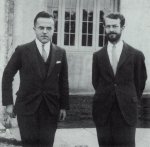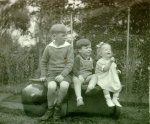
Pauling's Great Years of Achievement in Structural Chemistry, Part 2 (1933-1935)
1933
Pauling’s work with George Wheland on the resonance energy of benzene, naphthalene, and other compounds is published (the fifth paper in his series on the nature of the chemical bond).
Pauling uses the term "stochastic" to describe his approach to the determination of crystal structures by the diffraction of X-rays. In this method of treating very complex crystals, Pauling, with the aid of the general principles of molecular structure, first makes educated guesses of plausible structures. Then he arrives at the actual structure by using calculated and observed X-ray intensities to eliminate all the unlikely possibilities.
Between March 13 and April 14, Pauling gives fourteen lectures at Berkeley on the electronic structure of molecules with a special emphasis on the resonance of molecules among several electronic structures.
In May, he is elected the youngest member of the National Academy of Sciences.
In June, he receives his first honorary degree (Doctor of Science) from Oregon State College. At CIT, Lawrence O. Brockway, Ralph R. Hultgren, Sidney Weinbaum, and E. Bright Wilson, Jr. get their Ph.D. degrees (much of their work was done under Pauling’s direction).
In the spring and summer, Pauling and Sherman publish two articles on resonance energy: the first, empirical calculations, and the second, theoretical calculations (these two articles are the sixth and seventh in Pauling’s series on the nature of the chemical bond).
In the fall, Pauling applies for a three-year grant from the Rockefeller Foundation to support his experimental researches (based on measurements by electron and X-ray diffraction) and theoretical researches (based on wave mechanics) on the electronic structures of molecules.
Roger Hayward, a scientific illustrator (as well as a licensed architect and professional engineer), begins work with Pauling by providing him with clear and helpful illustrations for his lectures.
1934
Pauling becomes interested in hemoglobin, the red protein in the red cells of the blood. He applies for a three-year grant (1935-1938) from the Rockefeller Foundation to support his research on the structure of hemoglobin and other substances of biological importance.
He continues to supervise crystal-structure determinations, for example, enargite and calcium boride (with Sidney Weinbaum) and binnite (with E.W. Newman).
Pauling and M.L. Huggins publish their widely-used paper on covalent radii of atoms and interatomic distances in crystals containing electron-pair bonds.
During the summer, Pauling, who has switched his allegiance from the Republican to the Democratic Party, supports Upton Sinclair in his campaign to become governor of California (Sinclair wins a stunning triumph in the Democratic primary election).
Pauling and Brockway begin publishing their electron-diffraction determinations of the structures of molecules (their first paper, on the hexafluorides of sulfur, selenium, and tellurium is published in PNAS).
In November, despite the support of many Californians (including Linus and Ava Helen Pauling), Upton Sinclair, the Democratic nominee, is beaten by Frank Merriam, the Republican candidate, for the governorship.
1935
On a trip to Berkeley in the spring, Pauling discovers his theory that uses hydrogen bonds to explain the configurational entropy of ice, which he later publishes in JACS. It has been called "the most important American contribution to the modern crystallography of water."
Pauling and E. Bright Wilson, Jr. publish Introduction to Quantum Mechanics, with Applications to Chemistry. It becomes a popular textbook for introducing chemists and physicists to the new field of quantum mechanics.
Pauling publishes "The Oxygen Equilibrium of Hemoglobin and Its Structural Interpretation" in which he explains how oxygen molecules are attached to the iron atoms of hemoglobin. He begins his collaboration with Charles D. Coryell on the magnetic properties of hemoglobin.
In the spring, Pauling meets Alfred E. Mirsky, a professor in cell biology, at the Rockefeller Institute for Medical Research in New York City. They discuss hemoglobin and proteins, and Mirsky expresses an interest in pursuing their exchange of ideas at CIT.
Pauling immediately goes to Simon Flexner, the director of the Rockefeller Institute, and, within a short time, arranges for Mirsky to spend fifteen months in Pasadena.
During the summer, Pauling works on the hemocyanin present in the keyhole limpet at CIT’s marine laboratory at Corona del Mar. Mirsky also spends his summer at this laboratory, and he and Pauling begin to collaborate.
Pauling and Mirsky write a paper on the structure of native, denatured, and coagulated proteins in which they claim that biologically active protein molecules are held together by hydrogen bonds. They are able to explain, in a general way, how most globular proteins can be unfolded and denatured.
In the fall, Verner Schomaker arrives at CIT. He becomes an important collaborator with Pauling on the electron-diffraction work and on many other projects.
Table of Contents
- The Ancestry of Linus Pauling (The Paulings)
- The Ancestry of Linus Pauling (The Darlings)
- Linus Pauling's Childhood (1901-1910)
- Linus Pauling's Adolescence (1910-1917)
- Pauling's Years as an Undergraduate at Oregon Agricultural College, Part 1 (1917-1919)
- Pauling's Years as an Undergraduate at Oregon Agricultural College, Part 2 (1919-1922)
- Linus Pauling as a Graduate and Postdoctoral Student at the California Institute of Technology, Part 1 (1922-1923)
- Linus Pauling as a Graduate and Postdoctoral Student at the California Institute of Technology, Part 2 (1924-1926)
- A Guggenheim Fellow in Europe during the Golden Years of Physics (1926-1927)
- Early Career at the California Institute of Technology (1927-1930)
- Pauling's Great Years of Achievement in Structural Chemistry, Part 1 (1931-1932)
- Pauling's Great Years of Achievement in Structural Chemistry, Part 2 (1933-1935)
- Pauling's Increasing Involvement in Molecular Biology (1936-1939)
- The War Years, Part 1 (1940-1942)
- The War Years, Part 2 (1943-1945)
- The Postwar Years, Part 1 (1946-1947)
- The Postwar Years, Part 2 (1948-1949)
- Proteins, Passports, and the Prize (1950-1954)
- Increasing Involvement in World Peace, Part 1 (1955-1958)
- Increasing Involvement in World Peace, Part 2 (1959-1963)
- The Center for the Study of Democratic Institutions (1964-1967)
- The University of California, San Diego (1968-1969)
- Stanford University (1969-1972)
- An Institute for Science and Orthomolecular Medicine, Part 1 (1973-1977)
- An Institute for Science and Orthomolecular Medicine, Part 2 (1978-1981)
- The Years Alone: Pauling after the Death of Ava Helen, Part 1 (1982-1988)
- The Years Alone: Pauling after the Death of Ava Helen, Part 2 (1989-1994)
- About the Author



